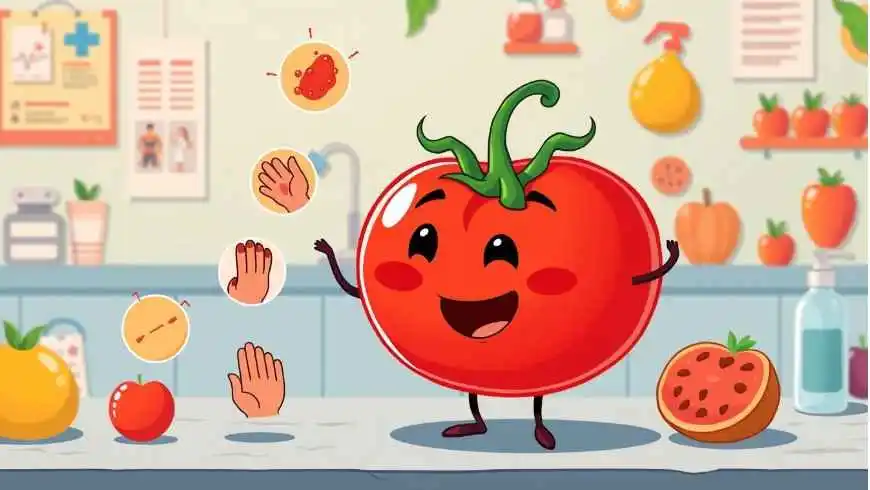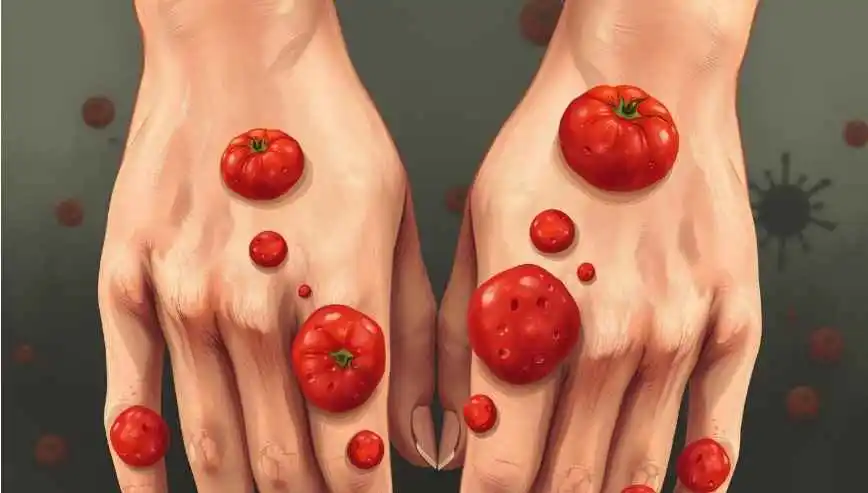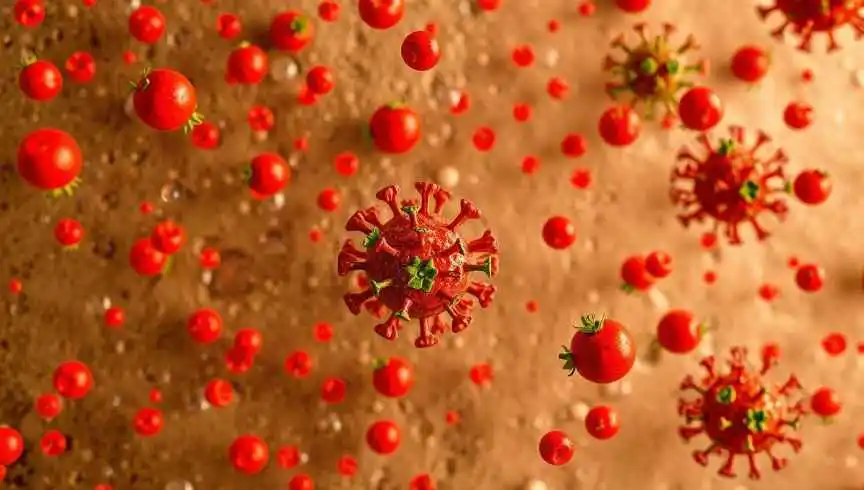Tomato Flu symptoms and prevention are key to keeping children safe. Explore how to protect your loved ones from this spreadable disease. ( tomato flu)
Introduction of Tomato Flu
Tomatos flu is an infectious disease that can be acquired through eating spoiled or infected tomatoes. It is estimated that the flu spreads fast and tends to affect children aged one to nine years. Because the new outbreak has raised concerns about its horrible consequences, in this blog, we try to focus on information regarding symptoms causes or treatment of the tomato flu virus. Let’s know more below.
In India, at least 82 children under 5 have caught the mysterious Tomato’s flu. This rare viral infection has hit Kerala hard. It is a big worry, especially for young kids.
Key Takeaways
- Tomato flu is a rare viral infection affecting children under 5 years old in India
- Symptoms include high fever, rashes, and intense joint pain, resembling chikungunya
- Transmission likely occurs through close contact, with no vaccine or antiviral treatment available
- Prevention measures focus on good hygiene, isolation of infected individuals, and boosting immunity
- Vigilance is crucial as the disease’s origin and potential for spread remain under investigation
What is Tomato Flu?
Understanding the Rare Viral Infection
Tomato flu, also known as tomato fever, is a rare viral infection found in parts of India. It mainly affects children under 5. The virus is called tomatos flu because it causes red blisters that look like tomatoes.

The first case was reported in Kerala, India, on May 6, 2022. Since then, it has spread to Odisha, Haryana, and Tamil Nadu. By July 26, 2022, over 82 children in Kollam district were infected.
This viral infection spreads easily through coughing and touching. It’s not deadly but can cause painful blisters, fever, and muscle aches. It also leads to dehydration.
Doctors find it hard to tell tomatos flu apart from other skin issues. It looks similar to COVID-19, chikungunya, and dengue fever. The exact cause is still unknown but is thought to be a coxsackievirus variant.
MUST READ INSURANCE IMPORTANCE
There’s no cure for tomatos flu yet. Doctors focus on easing symptoms and stopping it from spreading. They recommend preventive steps to control the virus.
Symptoms of Tomato Flu
The onset of symptoms of tomatos flu virus can be seen within a few hours or maximum 48 hours after eating the infected tomato. The most common symptoms include are:
Gastrointestinal distress: – Symptoms of tomato flu influence the digestion processes in one of the children afflicted with the flu. this includes stomach cramping, sore abdominal muscles and distension or feeling full.
Nausea and Vomiting: – Tomato flu is also a similar condition where the flu invades tomatoes making a person want to throw up. that many people who attack tomatoes suffer from nausea and even vomiting, which is a form of defense that the body makes to remove the tomatoes which are unwholesome.
Diarorhea: – another once in a while symptom of the novel disease tomatos flu is dehydration with loose and watery stools which are more than thrice daily without an effort to balance body fluids.
More Recognizing the Signs
The Tomato’s flu outbreak is getting a lot of attention. It’s important to know the symptoms of this rare viral infection. This illness mainly affects children in southern India and has unique signs.
One key symptom is large, bright red blisters that look like tomatoes. These blisters can pop up on hands, feet, and buttocks. They cause a lot of discomfort and irritation.
Other common symptoms include:
- High-grade fever
- Rashes
- Severe dehydration
- Tiredness
- Joint pain
- Body ache
- Lethargy
- Stomach cramps
- Fatigue
- Diarrhea
- Swollen joints
- Skin irritation
- Loss of appetite
- Discoloration in the hands, knees, and buttocks
- Runny nose
- Sneezing
Over 100 children in southern India have been affected by tomato fever symptoms. Most cases are in Kerala and Tamil Nadu. The disease spreads easily among kids, so it Is important to keep them indoors and avoid sharing items.
The exact cause of tomato virus symptoms is still being researched. Some think it might be a type of hand, foot, and mouth disease (HFMD). Tests show that infected children have the Coxsackie virus A16.

As scientists learn more about this Infection, it is vital for parents and caregivers to watch for symptoms. If your child shows any of these signs, seek medical help right away.
Causes and Transmission of Tomato Flu
The exact cause of Tomato’s flu is still a mystery. Expert thinks mosquitoes might carry the virus, like they do with chikungunya. Tomato’s flu spreads easily when people are close together.
The first case of tomatos flu was found in Kerala, India, on May 6, 2022. Over 82 kids under 5 have gotten it in Kerala. In Odisha, 26 kids aged 1-9 have also been diagnosed.
Tomato’s flu mainly spreads through close contact, especially among kids. Kids can spread it by touching things and putting things in their mouths. Keeping sick kids isolated for 5-7 days helps stop the virus from spreading.
Tomato flu’s symptoms are like COVID-19, but it’s not related to SARS-CoV-2. It might be linked to chikungunya or dengue fever in kids. The name comes from the red, painful blisters that look like tomatoes.
Researchers are still Finding out Tomato’s flu is causes and how it spreads. But, doctors stress the need to catch it early and isolate it. this is very important for young kids who are most at risk.
Tomato Flu Treatment

The treatment for Tomato’s flu, tomato fever, or tomato virus mainly involves managing symptoms. There are no specific drugs or vaccines yet. So, staying hydrated, resting well, and letting symptoms fade on their own is key. This usually takes 7 to 10 days.
Doctor’s suggest to take treatments for fever, body aches, rashes, and other discomforts. It is important not to pop the blisters to avoid more problems. Also, staying away from others helps stop the virus from spreading.
If symptoms get worse or new ones appear, see a doctor right away. They can offer the right care and watch over you to help you get better fast. With the right care, tomato flu can be managed well without needing special medicines or vaccines.
| Treatment Approach | Key Recommendations |
| Symptomatic Treatment | Manage fever, body aches, and rashes Avoid bursting blisters Maintain hydration Get adequate rest and sleep |
| Isolation and Monitoring | Isolate infected individuals to prevent further spread Seek medical attention if new symptoms arise or worsen Monitor the progress of the infection |
Managing tomatos flu means giving supportive care and letting the body fight the virus. By following the suggested treatment and getting medical advice when needed, people can get over this rare virus. They won’t need special medicines or vaccines.
“The primary focus for Tomato’s flu treatment is to manage the symptoms and support the body’s natural healing process, as there are currently no available antiviral drugs or vaccines.”
Prevention Measures for Tomato Flu
Tomatos flu is very contagious, so it is key to take steps to stop it from spreading. Health expert say we need to protect everyone, especially kids, from getting infected. Here are some important ways to prevent tomato flu:
- Wash your hands often with soap and water or use hand sanitizer.
- Keep your surroundings clean, especially things you touch a lot.
- Teach kids about washing their hands right and not touching their face.
- Make sure things like utensils and clothes of sick people are cleaned well.
- Stay away from people who have tomato flu to stop it from spreading.
- Eat foods full of vitamins and minerals to help your body fight off the virus.
- Get plenty of rest and sleep to help your body heal.
Reports say that flu has hit about 90 people in Kerala, Tamil Nadu, and Odisha. Kids under five are getting it the most. Even though adults might be less likely to get sick, it is still important to protect kids. We need to follow these steps to keep them safe.
| Prevention Measure | Importance |
| Hand hygiene | Reduces the risk of virus transmission through touch |
| Environmental cleaning | Eliminates potential sources of infection |
| Hygiene education | Empowers children to protect themselves |
| Sanitizing personal items | Prevents the spread of the virus through shared belongings |
| Avoiding contact with infected individuals | Limits the transmission of the virus |
| Maintaining a healthy lifestyle | Boosts the immune system to fight off the infection |
By following these steps, we can lower the chance of tomatos flu and keep kids safe. It is important to protect them from this new virus.

Conclusion- Tomato Flu
The Tomato’s flu is not a new virus, but a mix-up with hand, foot, and mouth disease (HFMD). This common illness in kids is caused by coxsackieviruses. The first reports in Kerala, India, raised worries, but more research showed it is just HFMD.
Even though it sounds scary, tomatos flu isn’t a big health risk. It’s not likely to spread widely. Keeping clean and seeing a doctor fast are key to handling it well. To stop the spread of false information from anyone. it is essential to believe facts from trustworthy sources such as WHO.
In Saudi Arabia, the chance of Tomato’s flu spreading is still low. But, it Is important for doctors and everyone to stay alert and follow the right steps for (HFMD). By being informed and taking action, we can keep our communities safe and handle health issues wisely.
FAQ- Tomato Flu
What is tomato flu?
Tomato flu is a rare viral infection that mainly affects children under 5. It is also called tomato fever. It is a type of hand, foot, and mouth disease. The virus causes red, painful burn that look like tomatoes.
What are the symptoms of tomato flu?
Symptoms include large, bright, red burn that look like tomatoes. You might also have a high fever, rashes, and severe dehydration. Other signs are tiredness, joint pain, and body aches. Other symptoms are lethargy, stomach cramps, diarrhea, and swollen joints. You might also have skin irritation, loss of appetite, and discoloration in certain areas. Runny nose and sneezing can also occur.
How does tomato flu spread?
Tomatos flu spreads easily, like other types of flu. It is believed to be caused by viruses carried by mosquitoes, especially those that cause chikungunya. Young children can get it by touching dirty surfaces or putting things in their mouths.
How is tomato flu treated?
Treatment involves staying hydrated and getting plenty of rest. It is important not to let the blisters burst. Doctors may suggest treatments for fever and body aches. It is crucial to isolate to prevent others from getting sick. If symptoms worsen or new ones appear, see a doctor.
How can tomato flu be prevented?
Preventive measures include good hand hygiene and keeping areas clean. Teach children about hygiene. Use separate utensils, clothing, and bedding and sanitize them often. Avoid contact with infected people. Eat nutritious food to boost immunity. And get enough rest and sleep.











